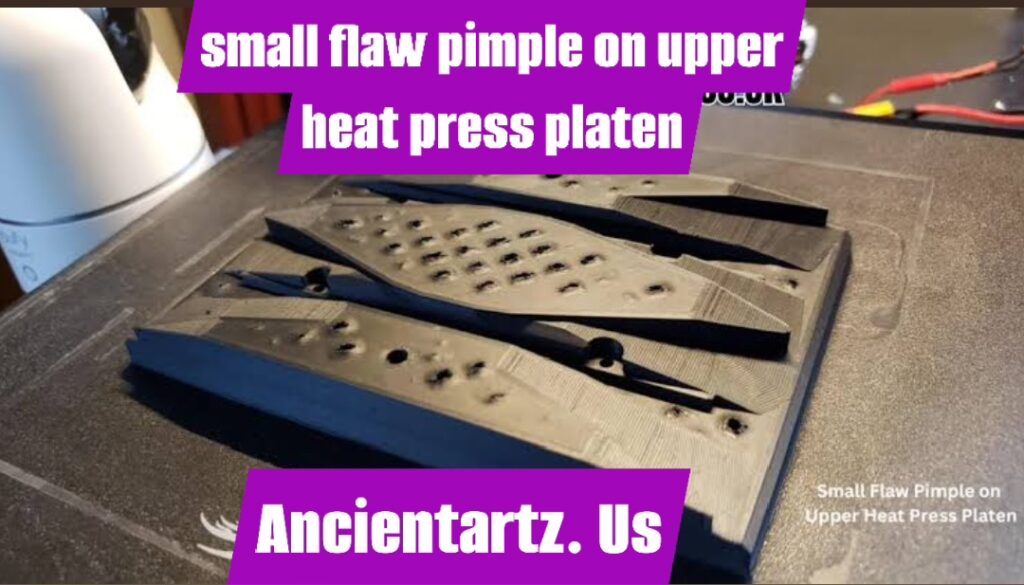Introduction
The efficiency of a heat press machine plays a pivotal role in industries ranging from textiles to custom merchandise production. Central to this equipment’s operation is the upper platen, which ensures uniform heat distribution and consistent pressure to achieve high-quality transfers. However, even the most well-maintained machines can encounter imperfections over time. Among these issues, a small flaw, such as a pimple or bump on the upper heat press platen, can have significant ramifications. Though seemingly minor, such imperfections can compromise the uniformity of pressure, resulting in uneven transfers, subpar finishes, and even damage to substrates.
Understanding the causes, identifying the impact, and implementing effective solutions for these flaws are critical for ensuring optimal performance of your heat press equipment. This article delves into the causes of pimples on the upper platen, explores the impact of such flaws on the overall process, and outlines comprehensive methods to address and prevent these issues. By taking a proactive approach, operators can extend the lifespan of their equipment, maintain high-quality output, and reduce downtime.
Let’s explore in depth how to identify, manage, and resolve these small flaws to ensure seamless heat press operations.
Causes of Pimples on the Upper Heat Press Platen
Manufacturing Defects
One of the primary causes of pimples on the upper platen lies in manufacturing defects. During production, inconsistencies in materials or errors in machining can leave behind minor imperfections on the small flaw, pimple on the upper heat press platen surface. While quality control processes are designed to minimize these occurrences, some flaws can escape detection. These defects often manifest as small raised areas or indentations that can disrupt the evenness of heat and pressure distribution.
Residue and Build-Up
Another common cause is the accumulation of adhesive residue, inks, or debris over time. Heat press machines operate at high temperatures, which can cause materials to stick to the small flaw, pimple on the upper heat press platen surface. Prolonged neglect or improper cleaning can lead to hardened build-up that forms bumps or pimples, negatively impacting the machine’s performance. Operators who frequently switch between different materials or transfer types are particularly prone to encountering this issue.
Wear and Tear
Routine use and prolonged exposure to high temperatures can gradually degrade the upper platen. Repeated cycles of heating and cooling may lead to material expansion and contraction, resulting in surface irregularities. Additionally, accidental impacts or scratches during operation can further exacerbate the problem.
External Factors
Environmental factors, such as exposure to moisture or contaminants, can also contribute to the formation of pimples. Rust or corrosion, for example, may develop on poorly maintained platens, leading to raised areas on the surface. Similarly, contamination from dust or particles can create uneven surfaces if not promptly addressed.
Effects of Pimples on the Heat Press Process
Uneven Heat Distribution
A smooth and uniform platen surface is essential for distributing heat evenly across the substrate. Pimples disrupt this uniformity, causing certain areas to receive more heat while others remain underexposed. This inconsistency can result in patchy or incomplete transfers, compromising the quality of the finished product.
Inconsistent Pressure
The heat press process relies heavily on even pressure application. A pimple on the upper platen creates a pressure imbalance, leading to uneven adherence of transfer materials. The affected areas may appear blurry, distorted, or partially unattached, significantly diminishing the product’s professional appearance.
Increased Reject Rates
When flaws on the platen go unchecked, operators may face a higher rate of rejected products. Misaligned designs, color inconsistencies, and incomplete transfers often necessitate redoing the work, leading to wasted materials, time, and resources. Over time, this can erode profitability and reduce operational efficiency.
Equipment Damage
Neglecting to address a pimple on the upper platen can lead to additional wear on other components of the heat press machine. Uneven surfaces may cause unnecessary strain on the lower platen, transfer pads, or substrates, potentially leading to further damage or the need for costly repairs.
Solutions for Managing Pimples on the Upper Platen
Regular Inspection and Maintenance
Frequent inspections can help identify minor flaws before they escalate into major problems. Operators should routinely check the platen’s surface for signs of wear, residue, or damage. Establishing a maintenance schedule that includes cleaning and inspection ensures that potential issues are caught early.
Proper Cleaning Techniques
Maintaining a clean platen surface is crucial for preventing and addressing pimples. Use a soft, heat-resistant cloth and non-abrasive cleaners to remove any adhesive residue, ink, or debris after each use. Avoid using sharp tools or harsh chemicals that could further damage the platen.
Surface Repairs
For minor imperfections, such as small pimples, consider using sandpaper with a fine grit to gently smooth the surface. Ensure that the platen is cool before attempting any repairs to avoid accidental burns. If the flaw persists or affects performance significantly, professional resurfacing or replacement may be necessary.
Protective Measures
Using protective covers or sheets can help safeguard the upper platen from residue build-up and environmental damage. Teflon sheets, for instance, create a barrier between the platen and the substrate, reducing the likelihood of contaminants sticking to the surface. Additionally, storing the heat press machine in a clean, dry environment minimizes exposure to moisture and dust.
Professional Assistance
In cases where the flaw is beyond DIY repair, consult a professional technician. They can assess the severity of the issue and recommend appropriate solutions, such as resurfacing or replacing the platen. Investing in professional services can save time and ensure optimal results.
Preventing Future Flaws
High-Quality Equipment
Purchasing a reliable heat press machine from a reputable manufacturer can reduce the likelihood of encountering defects. High-quality machines often undergo rigorous quality control, ensuring that the platens meet industry standards.
Operator Training
Proper training for operators can significantly reduce the risk of damage to the platen. Educating users on correct cleaning methods, material handling, and maintenance practices fosters a proactive approach to equipment care.
Monitoring Environmental Conditions
Controlling the environment in which the heat press machine operates can prevent moisture, dust, and other contaminants from affecting the platen. Using dehumidifiers or air purifiers in the workspace can help maintain an optimal setting for the machine.
Conclusion
A small flaw, pimple on the upper heat press platen, may seem insignificant at first glance, but its effects on the quality and efficiency of the heat press process are substantial. From uneven heat distribution to inconsistent pressure and increased reject rates, these imperfections can disrupt operations and diminish output quality. Understanding the causes, identifying the impacts, and implementing effective solutions are essential steps in managing and preventing these issues.
By adhering to regular maintenance practices, investing in high-quality equipment, and fostering a culture of proactive care, operators can ensure the longevity and performance of their heat press machines. When in doubt, seeking professional assistance can provide the expertise needed to address more complex flaws. Ultimately, taking the time to address small flaws today prevents larger issues tomorrow, safeguarding the quality and success of your heat press projects.
Frequently Asked Questions (FAQs)
Q1: How do I know if my heat press platen has a flaw? A1: Conduct regular visual inspections and run your hand over the surface to feel for bumps or indentations. If you notice uneven transfers or inconsistent pressure during operation, it’s likely that the platen has a flaw.
Q2: Can I repair a pimple on the platen myself? A2: Minor flaws can often be smoothed out using fine-grit sandpaper. However, for significant imperfections, it’s best to consult a professional technician to avoid further damage.
Q3: What materials can cause residue build-up on the platen? A3: Adhesive residues from heat transfer vinyl, inks, and other transfer materials can build up on the platen over time. Using protective sheets and cleaning after each use can minimize this risk.
Q4: Is it necessary to replace the platen if there’s a flaw? A4: Not always. Minor imperfections can often be repaired, but severe damage or recurring issues may warrant a replacement to maintain performance and quality.
Q5: How often should I clean my heat press platen? A5: Cleaning should be done after every use to prevent residue build-up. For thorough maintenance, inspect and deep clean the platen at least once a month.
Q6: Can environmental factors affect my heat press platen? A6: Yes, exposure to moisture, dust, and contaminants can lead to rust, corrosion, or build-up on the platen. Storing the machine in a clean and dry environment can prevent these issues.
Also Read This: Addressing Small Flaws: Understanding and Managing Pimples on the Upper Heat Press Platen



